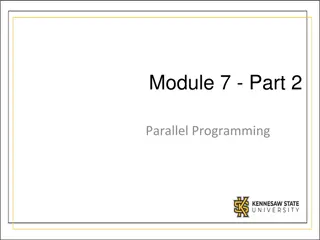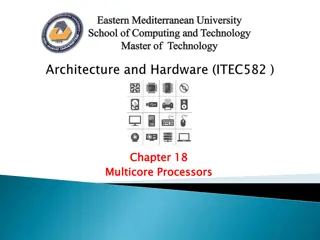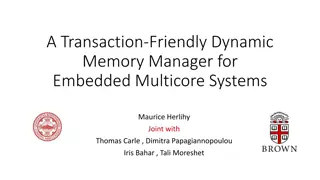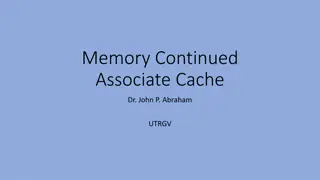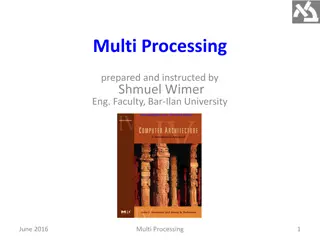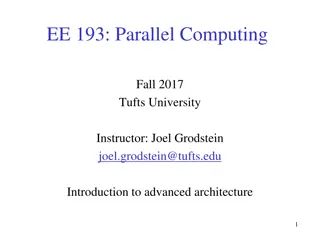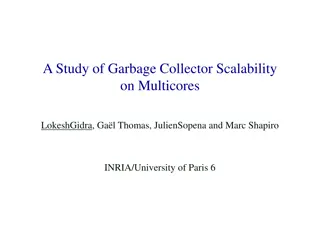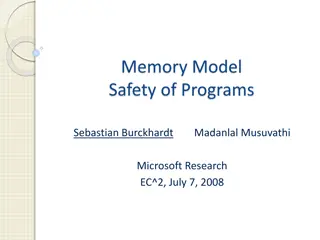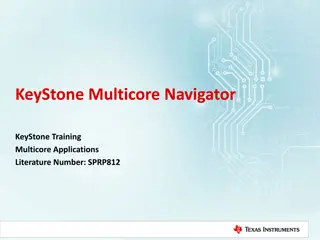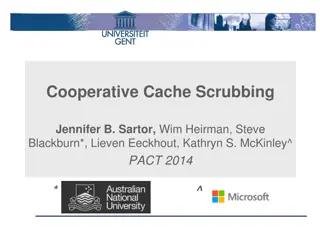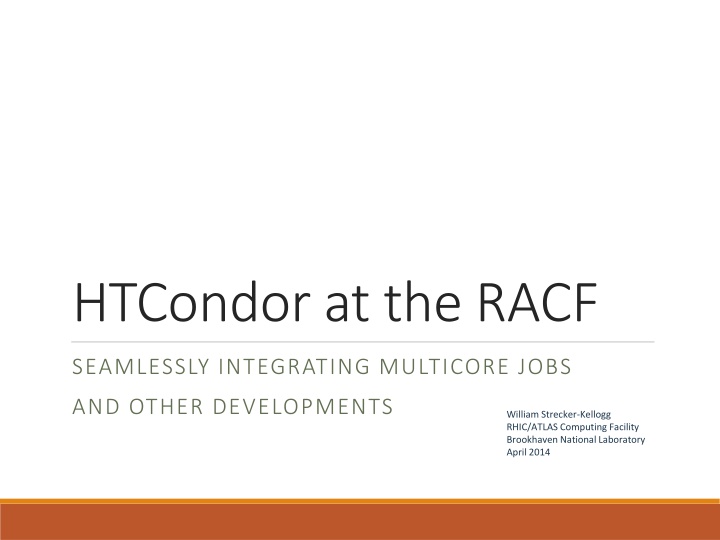
Integrating Multicore Jobs with HTCondor at RACF
Learn how HTCondor seamlessly integrates multicore jobs and other developments at the RACF, including supporting priorities, partitionable slots, policy changes, and defragmentation policies to optimize throughput and minimize latency.
Download Presentation

Please find below an Image/Link to download the presentation.
The content on the website is provided AS IS for your information and personal use only. It may not be sold, licensed, or shared on other websites without obtaining consent from the author. If you encounter any issues during the download, it is possible that the publisher has removed the file from their server.
You are allowed to download the files provided on this website for personal or commercial use, subject to the condition that they are used lawfully. All files are the property of their respective owners.
The content on the website is provided AS IS for your information and personal use only. It may not be sold, licensed, or shared on other websites without obtaining consent from the author.
E N D
Presentation Transcript
HTCondor at the RACF SEAMLESSLY INTEGRATING MULTICORE JOBS AND OTHER DEVELOPMENTS William Strecker-Kellogg RHIC/ATLAS Computing Facility Brookhaven National Laboratory April 2014
RACF Overview Main HTCondor pools PHENIX 12.2kCPU STAR 12.0kCPU ATLAS 13.1kCPU STAR/PHENIX are RHIC detectors Loose federation of individual users Smaller Experiments LBNE Dayabay LSST ATLAS tightly controlled, subordinate to PANDA workflow management, strict structure 2 HTCONDORWEEK 2014
Supporting Multicore Priorities and Requirements Keep management workload at a minimum No manual re-partitioning Needs to be dynamic and/or partitionable Support automatic demand-spillover Need to retain group-quota system with accept-surplus feature Maximize throughput minimize latency Same goals as above Attempt to support future developments in same framework More than just multicore High-Memory already used in this context (with caveat) Principle of proportional pain Okay to make multicore wait longer but no starvation is allowed 3 HTCONDORWEEK 2014
Supporting Multicore STEP 1: PARTITIONABLE SLOTS EVERYWHERE STEP 2: POLICY CHANGES Required change to monitoring Job-count no longer correct metric for measuring occupancy Preemption is no longer possible OK for now since not needed Slot-Weight can only be CPUs Needs to change in the future Minor script change with SlotID Slot<n> Slot<m>_<n> Defragmentation is necessary Detail next slide Works with no side effects Dedicated queues for now 4 HTCONDORWEEK 2014
Defragmentation Policy KEY CHANGE: NEGOTIATOR POLICY DEFRAGMENTATION DAEMON Start Defragmentation (PartitionableSlot && !Offline && TotalCpus > 12) Default policy is breadth-first filling of equivalent machines (Kflops SlotId) End Defragmentation (Cpus >= 10) Depth-first filling preserves continuous blocks longer (-Cpus) Rate: max 4/hr 5 HTCONDORWEEK 2014
Multicore in Dedicated Queues Works well now, issues were resolved Allocation is handled by group quota and surplus-share Dedicated queue per species of job Currently two high-memory (6Gb) and 8-core Changing requirements require manual action 6 HTCONDORWEEK 2014
Multicore in common Queue Works well, no starvation Lack of control over strict allocation of m. vs. n core jobs within queue Not currently done in ATLAS Issue of allocation control is just part of reason why Structural and not likely to change soon 7 HTCONDORWEEK 2014
Fixing bugs in HTCondor Last summer a period of intensive development/testing in collaboration with HTCondor team Built a VM testbed, rapid build & test of patches from HTCondor team Built new monitoring interface After many iterations had working config with Partitionable slots and Hierarchical Group Quotas with accept_surplus Should Stay Here Now it does! 8 HTCONDORWEEK 2014
Bugfix Testbed Details Rapid build, test, deploy cycle from git patches Email patch Rebuild condor Run test-feeder Job Feeder Defines groups in config-file with different random length-ranges and requirements Variable workload keep N jobs idle in each queue 9 HTCONDORWEEK 2014
Current Multicore Status Fully utilize PSlots All traditional nodes (x86_64) can have same config SLOT_TYPE_1 = 100% NUM_SLOTS = 1 NUM_SLOTS_TYPE_1 = 1 SLOT_TYPE_1_PARTITIONABLE = True SlotWeight=Cpus Fix works perfectly when accept_surplus is on for any combination of groups Major Limitation: SlotWeight=Cpus High-memory jobs can be accommodated by asking for more CPUs. Need ability to partition better and interact with global resource limits SlotWeight should be a configurable function of all consumable resources Other Limitation: No Preemption Required to support opportunistic usage 10 HTCONDORWEEK 2014
Issue With High Memory Jobs 1 2 1 ok, 2 ok, 3 not ok! 3 General problem: Inefficiencies in heterogeneous jobs scheduling to granular resources Worse as you add dimensions: imagine GPSs, Disks, CoProcessors, etc 11 HTCONDORWEEK 2014
Goals Need all the same behavior as we have now regarding groups and accept_surplus Want to be able to slice by any resource Sane and configurable defaults/quantization of requests Defragmentation inefficiencies should be kept to a minimum we are mostly there already! Overall we are something like of the way to our ideal configuration. 12 HTCONDORWEEK 2014
Problem of Weights and Costs What does SlotWeight mean with heterogeneous resources? Job of administrator to determine how much to charge for each requested resources E.g. (cpus + 1.5(ram exceeding cpus * ram/core)) Are these weights normalized to what CPU counting would give? If not then what does the sum of SlotWeights represent? Quotas related to sum of SlotWeights, needs to be constant pool-wide and independent of current job allocation if specifying static number! Cost functions need to be linear? Only dynamic quota instead (e.g. 80%X + 20%Y) 13 HTCONDORWEEK 2014
Implications A picture is worth 1000 words The more barriers between nodes that can be broken down the better MPI-like batch software with NUMA-aware scheduling making other machines like further away NUMA nodes? 14 HTCONDORWEEK 2014
ATLAS Load Balancing PANDA contains knowledge of upcoming work Wouldn t it be nice to adapt the group allocation accordingly A few knobs can be tuned surplus and quota Dynamic adjustment based on current pending-work Gather heuristics on past behavior to help Timeframe: Fall 2014 project will be picked up by a summer student this year 15 HTCONDORWEEK 2014
PHENIX Job Placement Data stored on PHENIX nodes (dCache) New this year is RAW data is placed hot off the DAQ Reprocessing no longer requires second read from tape Less tape wear, faster no stage latency Analysis continues to read input from dCache No intelligent placement of jobs HDFS-like job placement would be great but without sacrificing throughput Approach: Need to know where files are first! Need to suggest placement without waiting for the perfect slot Started as proof-of-concept for efficacy of non-flat network Testing Infiniband fabrics with tree-based topology 16 HTCONDORWEEK 2014
PHENIX Job Placement File placement harvested from nodes and placed in database Database contains map of file->machine Also contains machines->rack and rack->rack-group mapping Machines run a STARTD_CRON to query & advertise their location Job-RANK statement used to steer jobs towards machines where their files are E.g: (3*(Machine== a || Machine== c )) + 2*(Rack== 21-6 ) + (RackGroup == 10 ) Slight increase in negotiation time, upgraded hardware to compensate Several thousand matches/hr with possibly unique RANK statements Working on modified dCache client to directly read file if on local node 17 HTCONDORWEEK 2014
PHENIX Job Placement Results We achieved expected results with machine-local jobs >80% on an empty farm ~10% on a full farm All localization in rack-group >90% empty farm ~15% full farm Argues that great benefit could be gained from utilizing multi-tier networking Without it, only machine-local jobs benefit 18 HTCONDORWEEK 2014
PHENIX Job Placement Results 1. 2. 3. 4. Machine-Local Rack-Local (exclusive of Machine-Local) All Localized (Sum 1. + 2.) All Jobs 19 HTCONDORWEEK 2014
PHENIX Job Placement Results 1. 2. 3. Machine-Local Rack-Local (exclusive of Machine-Local) All Localized (Sum 1. + 2.) 20 HTCONDORWEEK 2014
PHENIX Job Placement Results SIMULATED NO LOCALIZATION RESULTS FROM LOCALIZATION 1. 2. 3. Machine-Local Rack-Local (exclusive of Machine-Local) Non-Local Histogram of portion of jobs in each state taken in 1 hour intervals *Plots generated by Alexandr Zaytsev 21 HTCONDORWEEK 2014
THANK YOU Questions? Comments? Stock Photo? 22 HTCONDORWEEK 2014
Configuration Changes TAKING ADVANTAGE OF CONFIG- DIR Old Way Main Config: LOCAL_CONFIG_FILES = /dir/a, /dir/b Since 7.8 Condor supports a config.d/ directory to read configuration from Order: /etc/condor/condor_config (or $CONDOR_CONFIG) 1. /dir/a 2. /dir/b 3. More easily allows programmatic/automated management of configuration New Way Main Config: LOCAL_CONFIG_DIR = /etc/condor/config.d Refactored configuration files at RACF to take advantage LOCAL_CONFIG_FILES = /dir/a, /dir/b Order: /etc/condor/condor_config (or $CONDOR_CONFIG) 1. /etc/condor/config.d/* (in alphanumeric order) 2. /dir/a 3. /dir/b 4. 23 HTCONDORWEEK 2014

